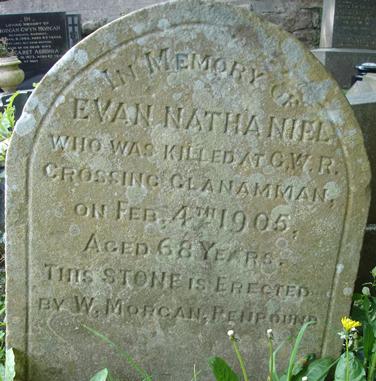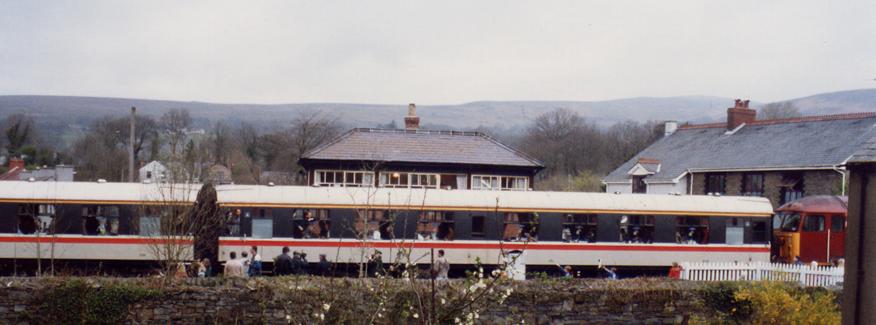Some Captured History of Glanamman and GarnantGlanamman Railway Station c.1910
The Llanelly Railway and Dock Company, opened its line from Pontardulais to Cwmamman in 1840. The Llanelly Railway line was taken over by The Great Western Railway on 1st January 1873. The station pictured above, at Station Road, Glanamman, was known as Cross Keys station. In the background of the above image; on the left, "Frondeg", the former home of the Folland Family can be seen. This became Amman Valley Hospital in 1936. Horney road was then renamed "Folland Road". At Christchurch, Garnant, is a headstone for Evan Nathaniel, a 68 year old man from Alltwen, but who was described as having "no fixed abode". He was killed at the railway Crossing near Glanamman Station, on 4th February, 1905. The South Wales Daily Post reported that an inquest into his death was held at the Amman Hotel, Glanamman. Evan Nathaniel was found by Henry Folland, manager of the Raven Tinplate works at Glanamman, who heard groaning after the 10pm train had passed Glanamman Station. On investigation, he found the living, but mutilated body of the poor man laying between the tracks, with his right leg severed below the knee. The driver stated that he sounded his whistle approximately 150 yards (metres), from the crossing and that he saw nothing on the line. The inquest returned a verdict of accidental death, attributing the cause to shock from the injuries received. Kelly's Directories for the area, tell us that in 1910, the station master of Glanamman Station was David T. Williams and in the 1923 edition of the directory, the station master was named as Benjamin Thomas. The 5th Feb, 1914 edition of the Amman Valley Chronicle reported that there had been a great advance for the G. W. Railway as they had installed gas at their stations. The article, however, criticised the company for having had the same timetable since the 1850's, when the line was owned by the Llanelly and Dock Company. The writer called for better facilities for travelling. Mr Albert Lewis of Llwyn-y-Fedwen, Glanamman, had a close escape on 1st July, 1936, when a lorry that he was driving was hit by a mineral train. A young lad opened the gates at Abergrenig Crossing, without noticing that a train was approaching. The truck was returning empty after making a delivery to Glanamman number 2 Colliery, when the front of the lorry was struck from the side and pushed approximately 30 feet along the track, eventually swinging to the side, leaving it hanging precariously over the railway embankment. The driver, shaken, but unharmed, remained in his crushed cabin until the train had passed. The Amman Valley Chronicle, which reported the incident in it's 2nd July, 1936 edition, also referred to Mr Lewis' charmed life. Twenty four years previously, he had been trapped underground at the Tarreni Colliery for 12 hours after a roof fall. Sometime later, a journey of runaway trams crashed into a siding where he was filling his lorry. The front tram caught his leg, fracturing it while he was trying to escape. The last of the regular passenger trains to run through Cwmamman came from Brynamman. There is some uncertainty as to when; various sources quoting different dates, but it is likely that the regular train was last seen passing Glanamman Railway Station on the 18th August 1958. Coal trains, however, with their loud diesel engines, continued through Cwmamman after this date. Since that time, there have been occasional "Rambler Specials" using the line and one of these passed through Cwmamman c.1997 and is pictured below.
A"Special" which travelled through Glanamman circa 1997. (Photo taken by Mrs Dilys Jenkins). Although the line was not used for several years, the Signal Box is still in use as the meeting place for the Amman Valley Railway Society, who are endeavouring, under the leadership of Captain Michael Smith, to eventually see the reintroduction of passenger trains along the Cwmamman Line. More information on the Cwmamman Railway can be found on the "Cwmamman Railway" page on this site. Thanks to Gomer Davies, archivist for the Amman Valley Railway Society, his contribution to this page. Thanks also to Mrs Dilys Jenkins and to the South Wales Guardian for allowing me to use information from the Amman Valley Chronicle. |


